The Fundamentals of Roasted Pumpkin & Squash Seeds
There are a lot of misconceptions about roasting pumpkins and guards. Some of them are old wives tales that don't hold up under scrutiny. And some of them are just bad advice from people who appear to have no idea what they're talking about! Either way, roasted pumpkin seeds and roasted squash seeds are quick and easy to make. And oftentimes a lot simpler than most recipes will make out!
Of course, you're likely doing more than just making roasted pumpkin seeds! Check out The Fundamentals of How to Roast Pumpkins, Squash, and Other Gourds for more information on roasting various gourds. I also often cook with these ingredients have recipes that include Pumpkins and Squash.
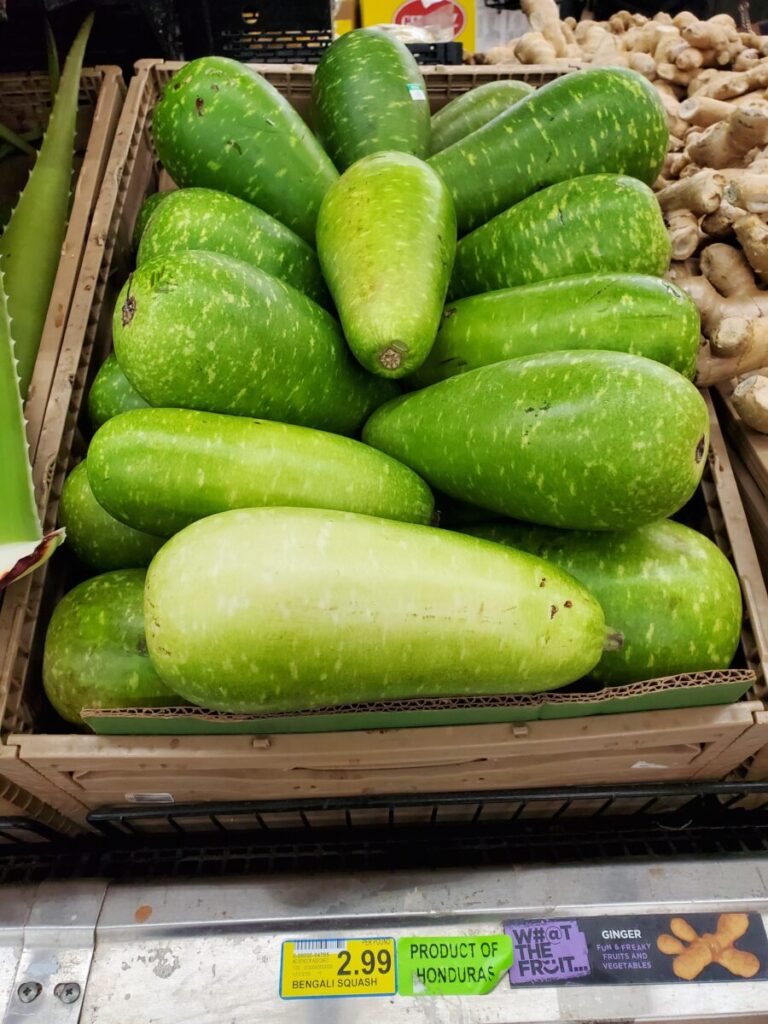
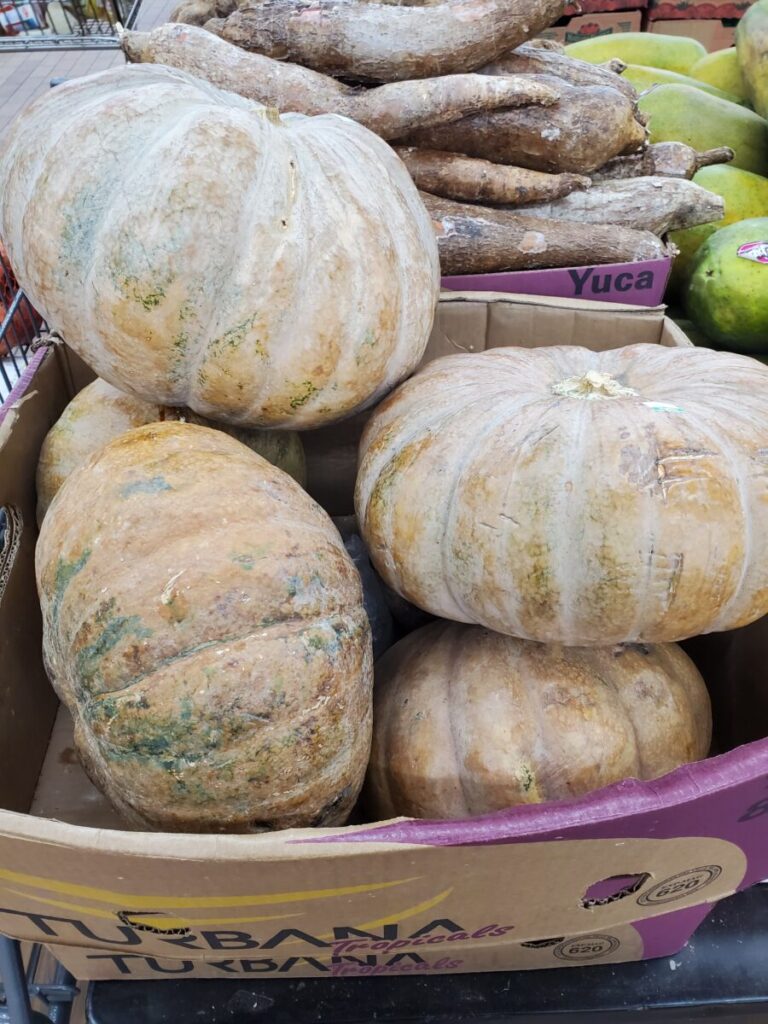
What Type of Seeds Can You Roast?
A lot of us grew up roasting pumpkin seeds after scooping out the guts to carve them or maybe even the seeds of pie pumpkins for pumpkin pie. But there are so many other seeds that can be roasted! The next time that you cut into a butternut or acorn squash, don't forget to roast the seeds, too!
Almost all pumpkins, winter squash, and other gourd seeds can be roasted.
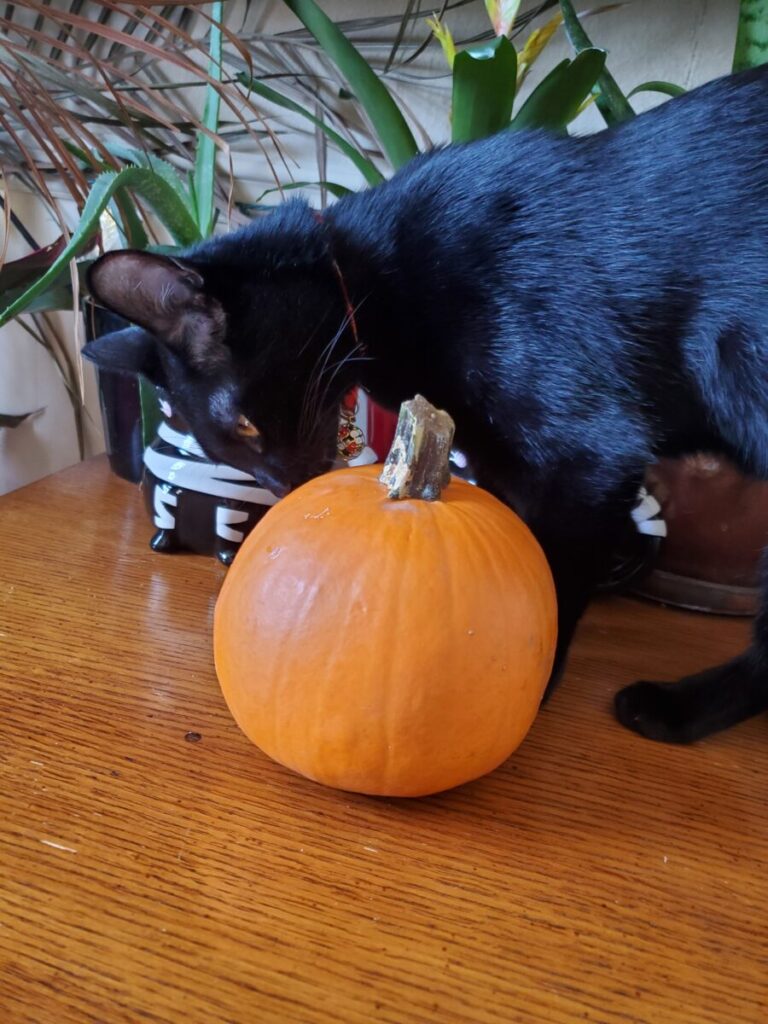

Pumpkins
Roasted pumpkin seeds are a staple. Everything from pie pumpkins (colloquially also referred to as sugar or baking pumpkins) to carving pumpkins have edible seeds. Although I wouldn't necessarily recommend eating jack-o-lanterns or other ornamental pumpkins. These are grown for their size and appearance, not for their taste!
So, while they are still edible, pie pumpkins are what you're going to want to use for cooking and baking purposes. But the seeds are perfectly delicious to eat! So, don't toss them out with the pumpkin guts and make sure to roast them for a great snack!
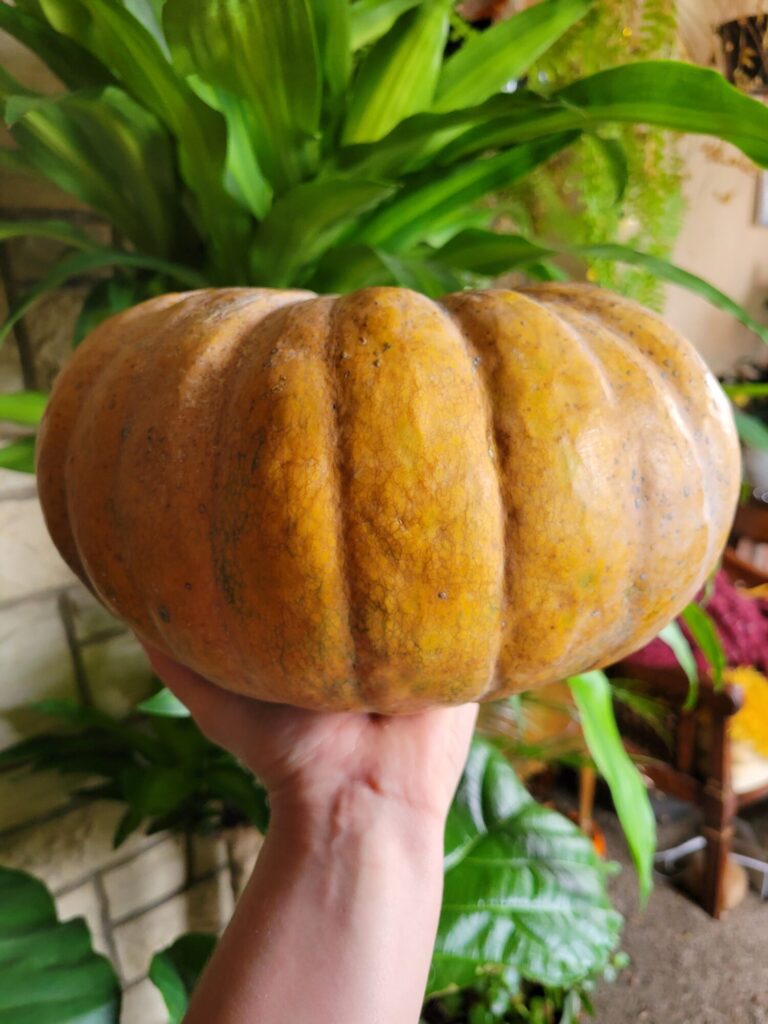

Winter Squash
Winter squash are generally considered hard-skinned squash harvested from late summer to early winter. These include pumpkins, butternut squash, acorn squash, kabocha squash, etc. This is in opposition to summer squash, which have a soft, edible skin. Think more zucchini and yellow squash that are harvested earlier in the summer.
Winter squash aren't an actual classification of squash, though. Pumpkins, squash, and gourds are all a part of the Cucurbitaceae cucumber family. More specifically the Cucurbita Lundelliana gourd genus. However, this is broken up into 9 species of plants. The most common are Cucurbita maxima Duchesne (winter squash), Cucurbita moschata Duchesne (crookneck squash), and Cucurbita pepo Lundelliana (field pumpkin). And none of these are really broken up how we would colloquially refer to them.
Kabocha squash, butternut squash, and acorn squash can all be found in most grocery stores year-round. I would call all of these "winter squash" because they're hard-skinned and harvested during the more wintry months. However, they're all in separate plant species! Acorn squash, pie pumpkins, and zucchini are all more closely related to one another than acorn squash is to butternut squash or kabocha squash!
The term "winter squash" is really less an actual classification than what we call similar looking squash harvested later in the season. But all of these squash with actual seeds are good to roast.


Summer Squash
"Summer squash" are the more juvenile squash that are harvested in the summer months. These include soft-skinned or tender squash varieties, like zucchini and yellow squash. While these do have seeds and you could potentially try and scoop them out to roast... They have much smaller seeds compared to winter squash and I wouldn't bother! Particularly because these small, soft seeds are edible raw.
If you really wanted to roast summer squash, I would suggest roasting the entire squash, seeds, skin, and all. Some people like to peel them, but this isn't necessary. Every part of the produce is edible. Plus the skin will get a nice char when roasted. Although this is all personal preference and an article for a different time!
Gourds
The term "winter squash" tends to encompass the squash varieties that we usually eat. As I've mentioned, this is more of a colloquial term than an actual definition. The Cucurbita Lundelliana is the broader "gourd" genus encompassing all types of pumpkin and squash.
However, there are also ornamental gourds that we also tend to simply refer to as "gourds" as well. So, while the broader term "gourd" refers to all squash and pumpkin, the more specific ornamental "gourd" is oftentimes not the same squash and pumpkins that we're referring to.
Most of these ornamental gourds, like daisy, turban, and bottle gourds that you might find decorating a Thanksgiving table are edible. Although not all of them produce enough flesh to make it worth eating them! They're also not grown for eating, so some of them aren't the most tasty variety. However, if you do find yourself with these ornamental gourds, most of the seeds are still edible.
If you have any question, a quick Google search should be able to clear up whether the gourds are edible or not. Generally, angel wing, apple gourd, baby bear, gooseneck, and Jack be quick are considered inedible (The Best Wine from Italy's Gourds that are Not Edible).
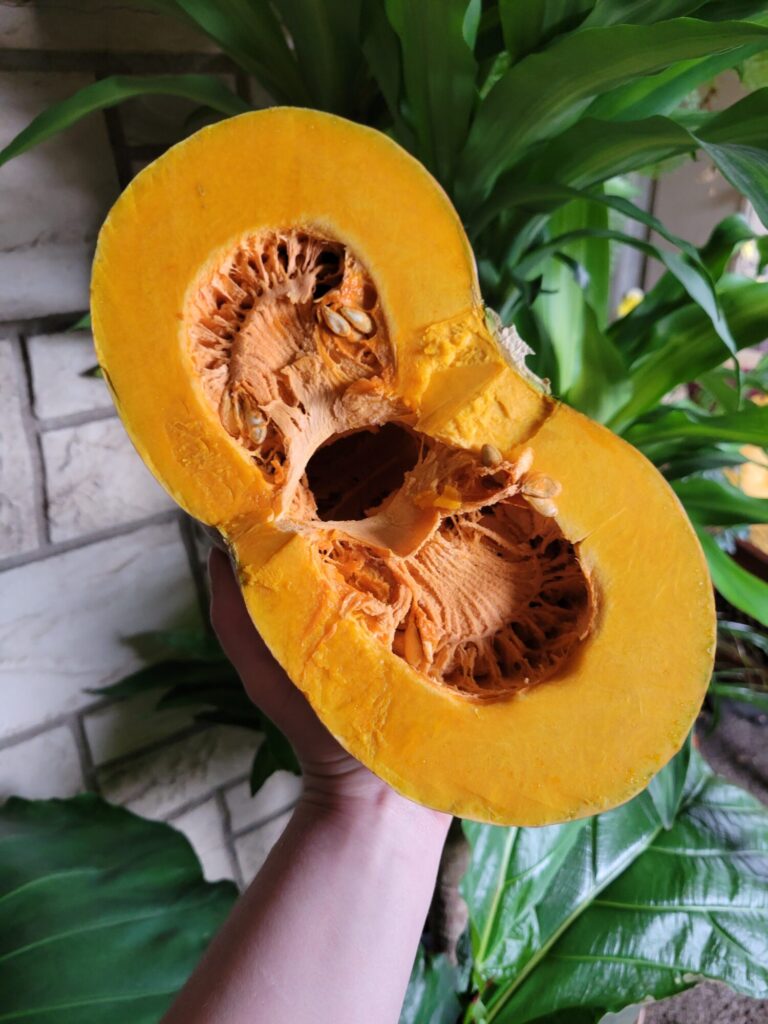

Do You Need to Wash, Dry, or Boil Seeds?
Some people will wash and even dry or boil the pumpkin seeds. This has always baffled me to no end! Everything inside of the pumpkin is edible. And seeds can't be roasted when dry! They will stick together and burn. That's why you add oil.
If you leave the seeds coated in a little bit of pumpkin juice, they don't need as much oil to roast. They also taste better because they retain more of the natural pumpkin flavor.
So stop rinsing them!! And roast them right after you scoop them out of the pumpkin! Gooeyness and all. Just make sure that there are no stringy pieces left because these aren't as tasty, texturally unpleasant, and burn faster than the pumpkin seeds will.
People make all sorts of rationales for washing their seeds. But it seems that washing the seeds is an old wives tale and just habit at this point. Most people seem to have never actually tried to eat unwashed seeds and simply assume that that's what you're supposed to do.
I have never found issues with digestion or easier cooking with washed seeds. To the contrary, I've found them more difficult to cook! There is some legitimacy to having some gastric distress if you don't get enough fibre in your diet and suddenly eat more fibrous foods. However, this isn't because of anything inherent in high fibre foods that is toxic or inedible. The same kind of thing happens when you don't eat sugar and then eat a bunch of cake.
Oftentimes the simplest way to do things is easier. The less complicated something is, the less room for error there is! They also take a fraction of the time to roast this way.

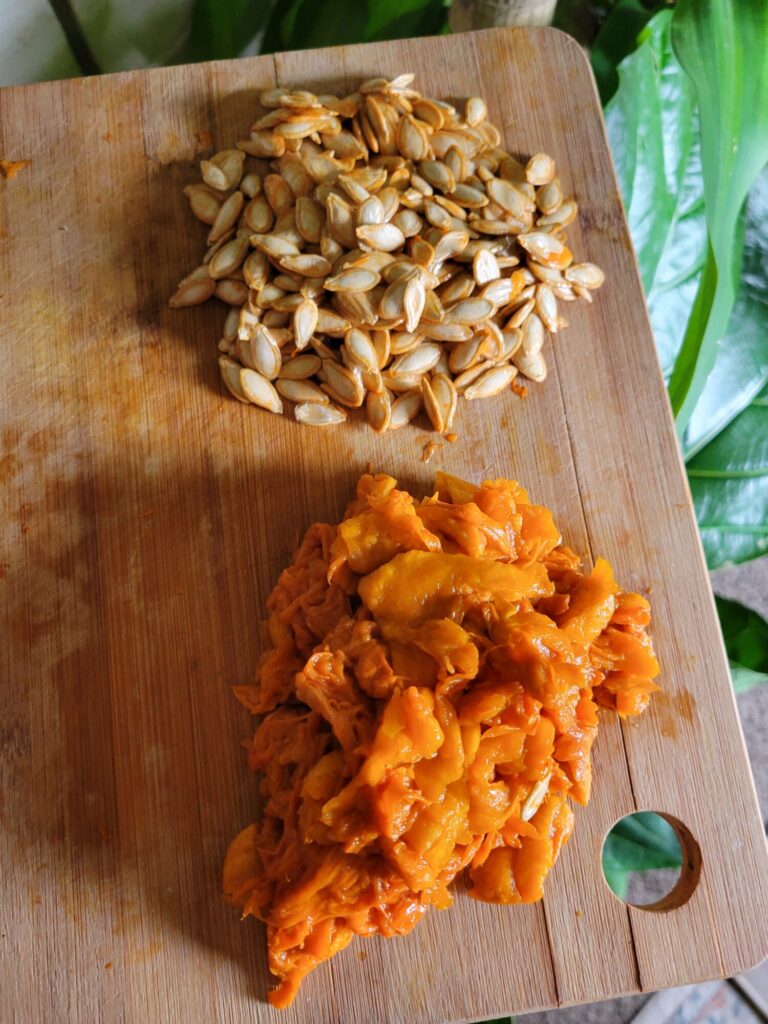
How Do You Roast Different Sized Seeds?
This is the real clincher here. Although a wide variety of seeds are delicious to roast, they won't all cook in the same amount of time! I have gotten to the point where I've almost stopped trying to time them. I just start at 5 minutes and then check them periodically until the seeds begin to turn a golden brown.
This is because you really don't want to overcook seeds. Pumpkin and squash seeds are supposed to be crisp and salty. Once they've burned, there is no going back! The charred flavor will forever permeate!
So, instead of following a hard fast rule of how long to roast seeds, I just keep checking them until they're done. It's better to overcheck these than risk burning them. After all, it's not a soufflé! Go ahead and check the oven as many times as you need to.
Also note that roasted pumpkin seeds are kind of the staple for this recipe. Anything larger than a pie pumpkin's seeds, like a calabaza squash, will need longer cooking times. And anything smaller than a pie pumpkin's seeds, like a butternut squash, will need shorter cooking times.

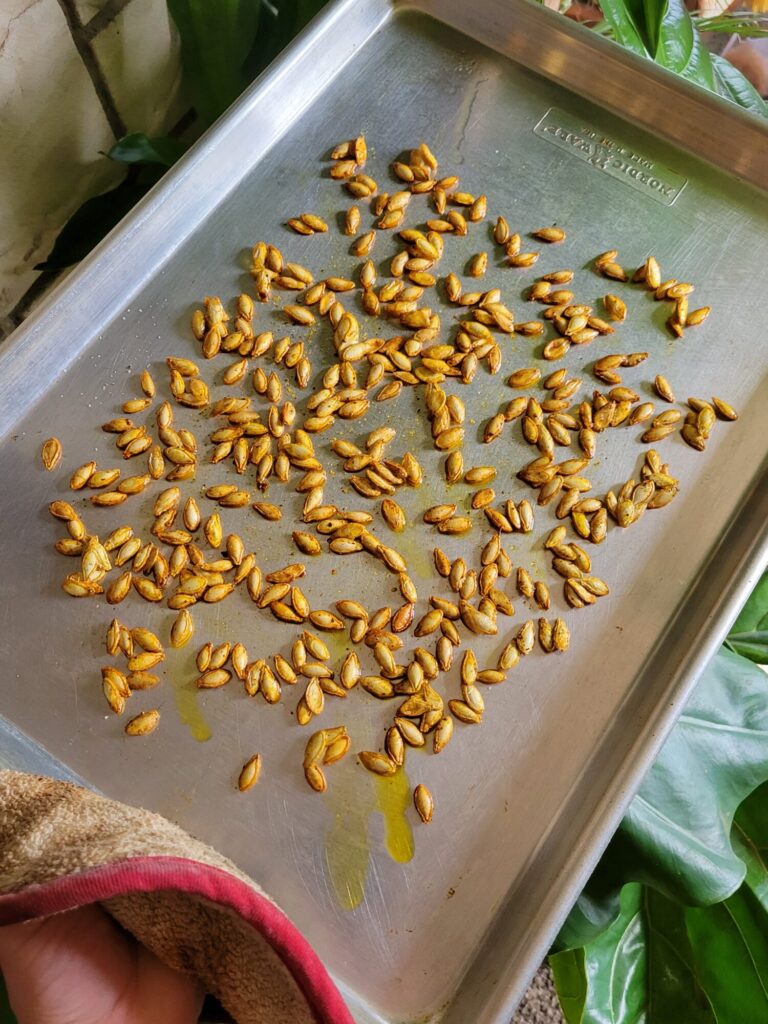
Cooking Temperature
I tend to roast pumpkin seeds and squash seeds when I'm making something else. After all, I cut into the butternut squash or pie pumpkin for a reason! What I'm making, what gourd I'm using, and whether I'm roasting it whole or diced can all affect the temperature that I'm roasting it at, though.
The good news, though, is that you can roast seeds at various temperatures. I tend to roast them at somewhere between 350 and 450 degrees Fahrenheit. Anything too low and the seeds tend to dry out before they're cooked. And anything too high and the seeds tend to burn too quickly. But there is quite a bit of wiggle room here temperature wise. Just check them often enough to roast them to a perfectly golden brown.
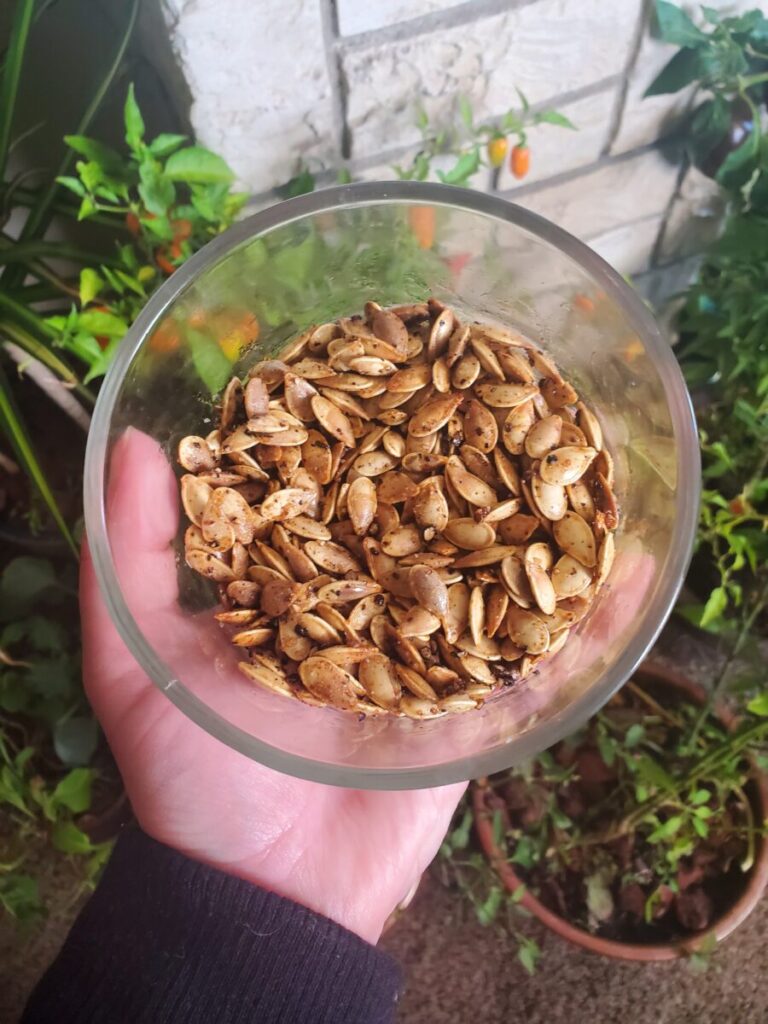

Seasoning Seeds
You can easily season pumpkin seeds with other flavors. I tend to stick with the traditional salt and pepper. But you can mix it up with some flavors!
Just sprinkle them on before roasting. This will result in the most flavorful seeds because it will permeate during the roasting process. However, you can also add seasoning after they come out of the oven. I tend to adjust the amount of salt in particular. You can always add more later. But, if you overdo it, there's no going back!
Feel free to add whatever spices you like for seasoning as well. Oregano, paprika, curry, garlic, cinnamon, and dill are often used in roasted pumpkin seeds and roasted squash seeds. Although the sky is the limit!
I usually flavor mine for what I plan on using them with. You can either eat them as a snack or toss them on top of a dish. Sometimes neutral is better or more traditional, other times it might be fun to spice things up or use complimentary spices to the main dish.
Gallery
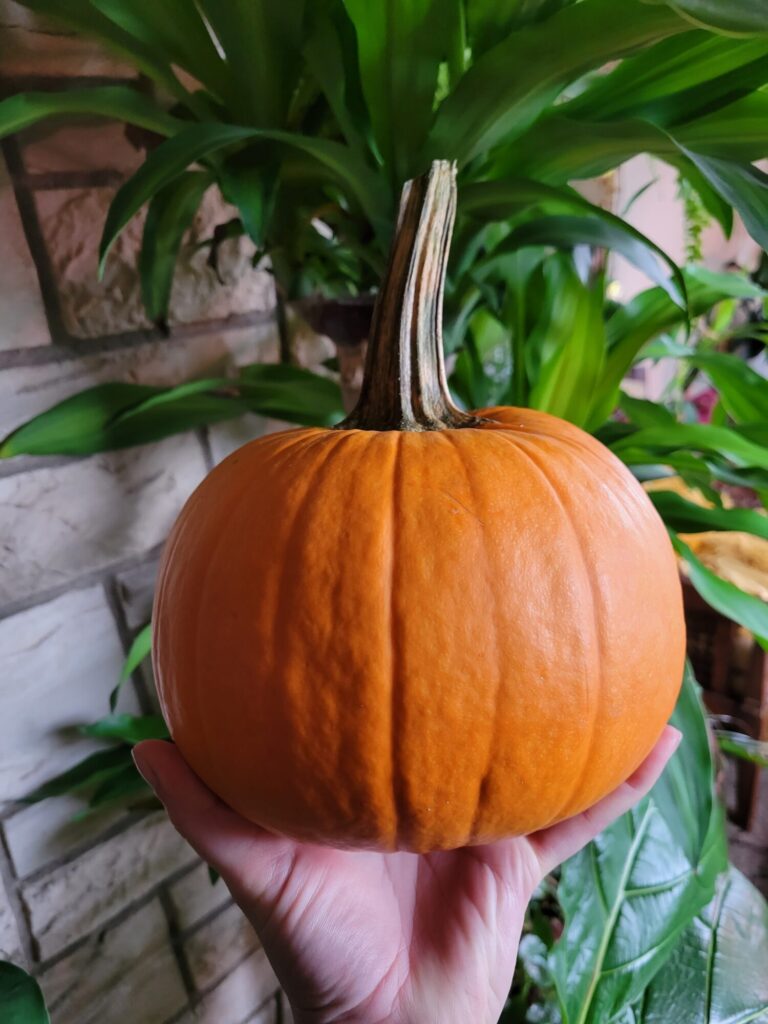
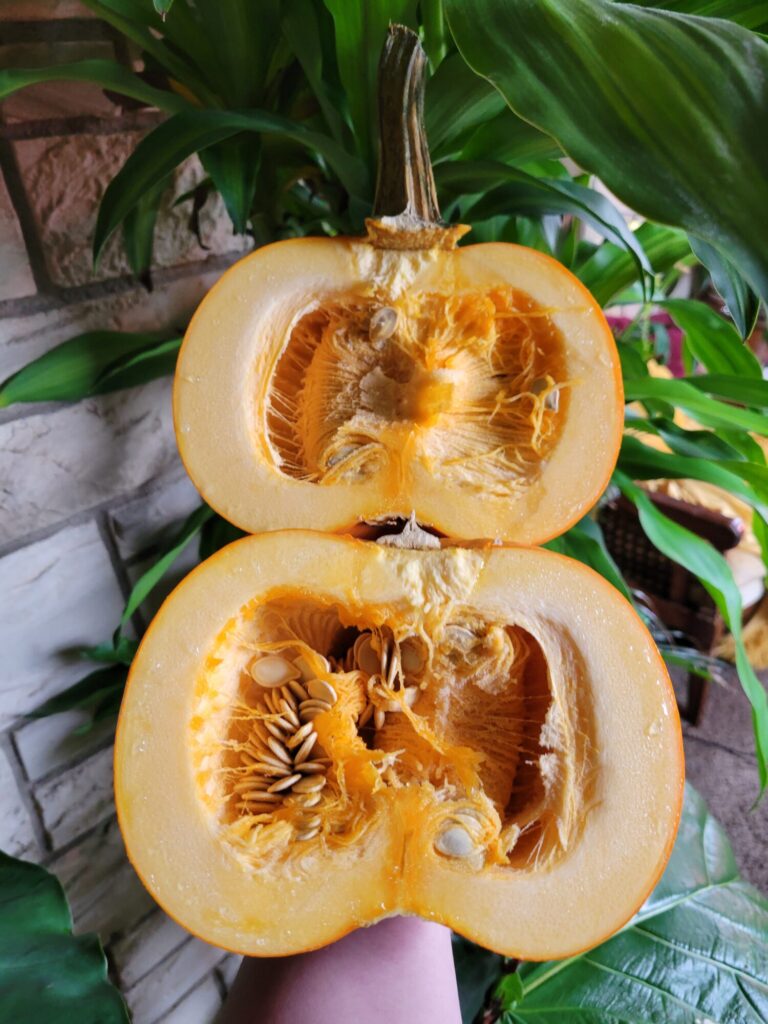
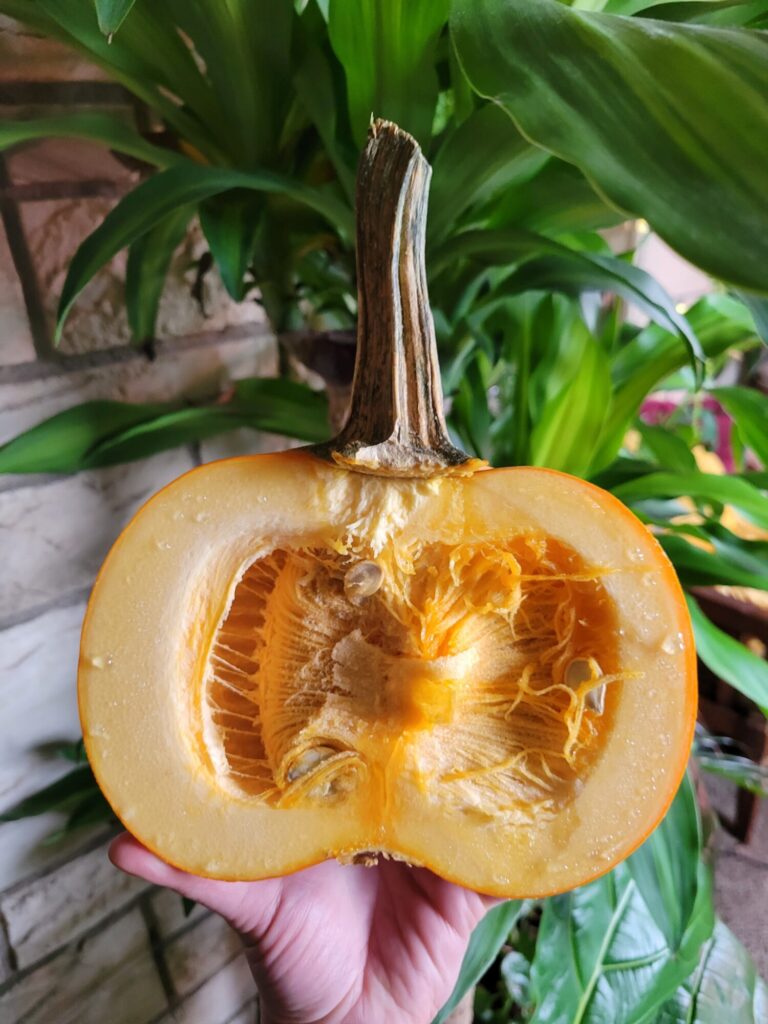


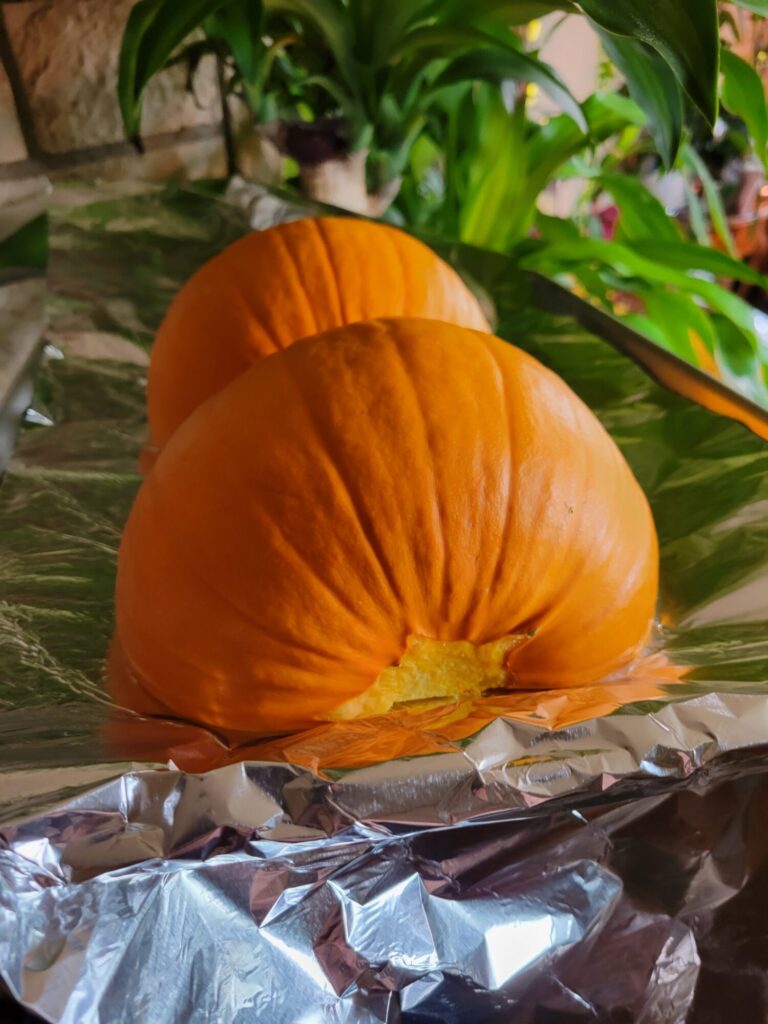
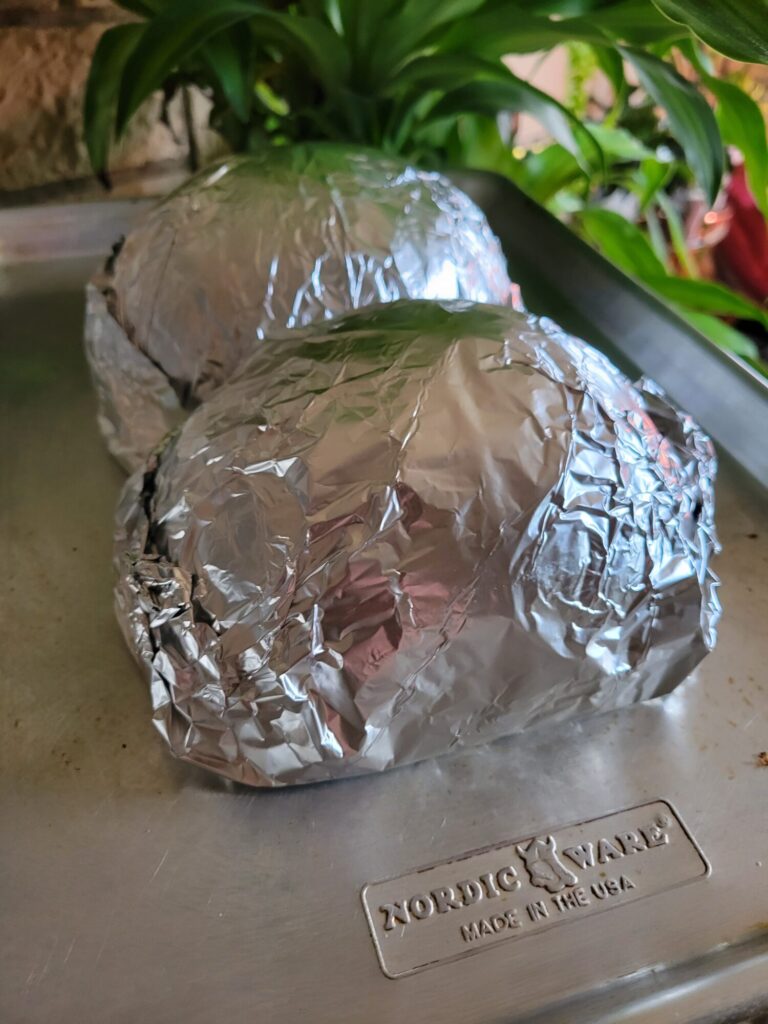

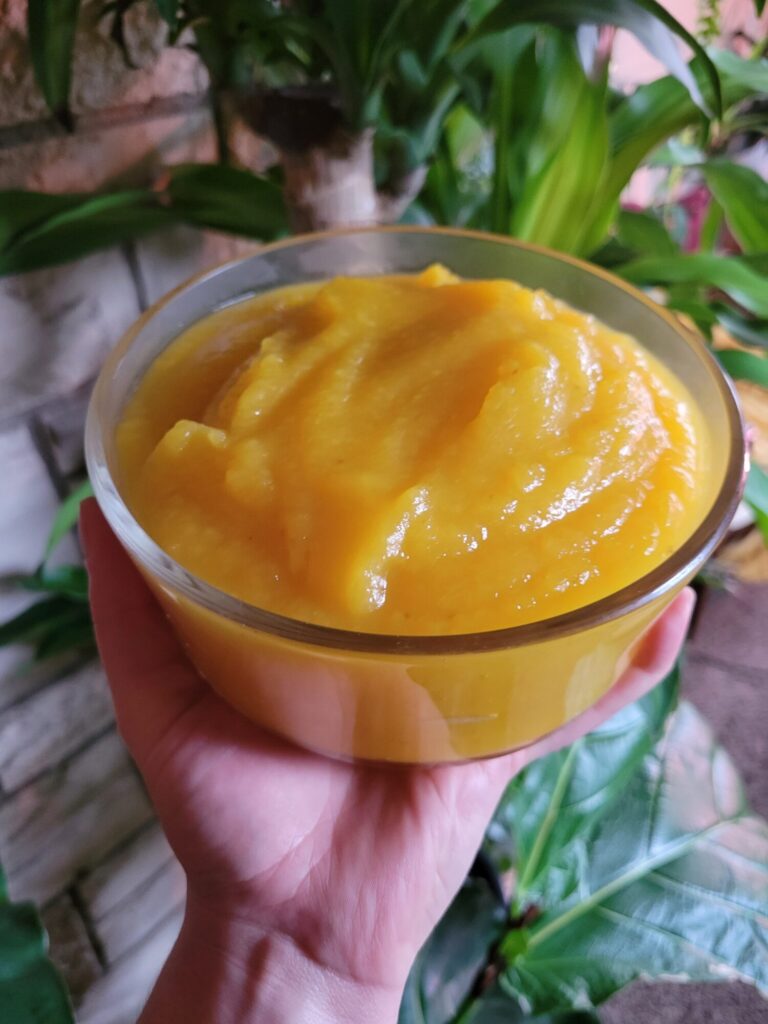
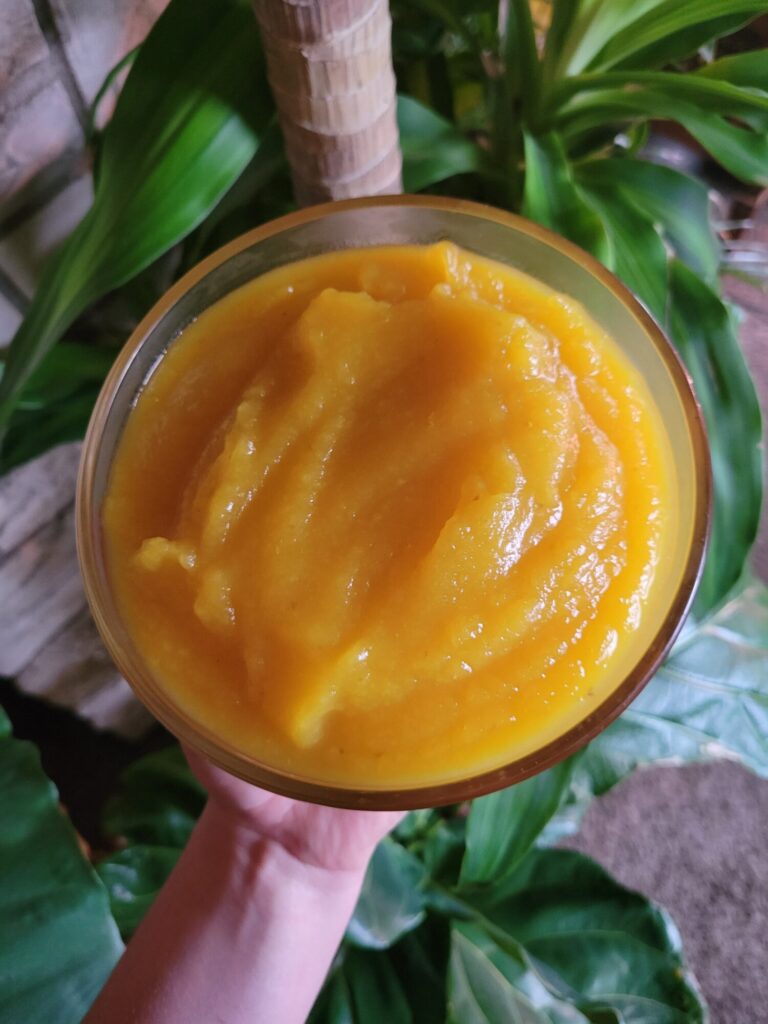
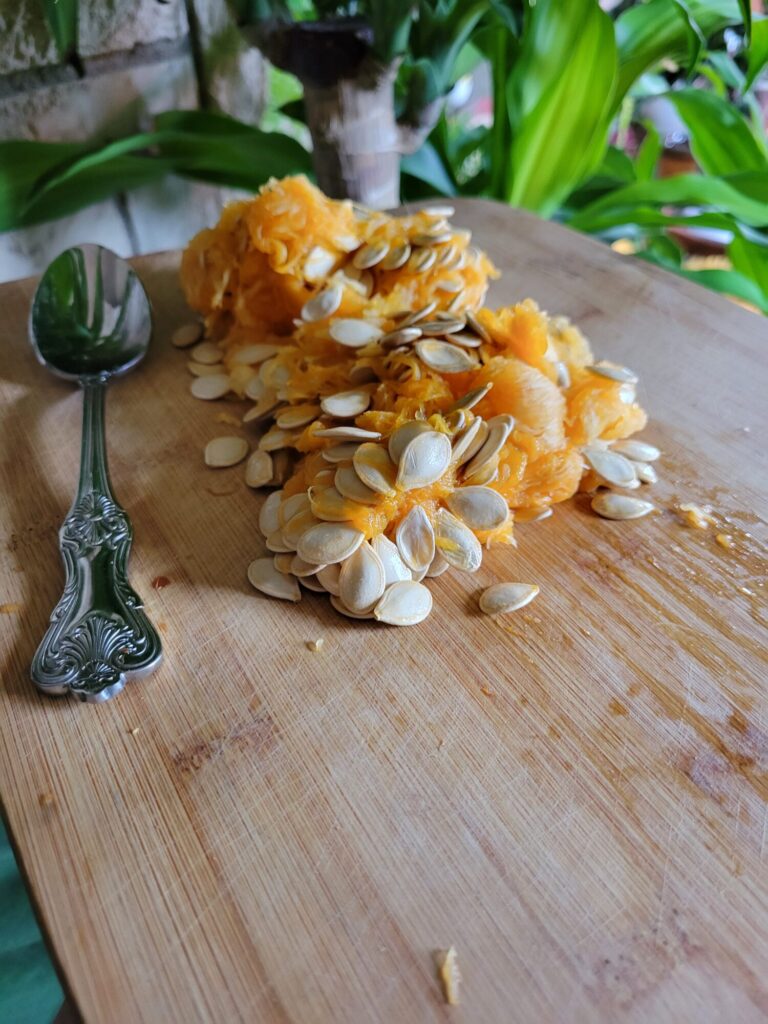
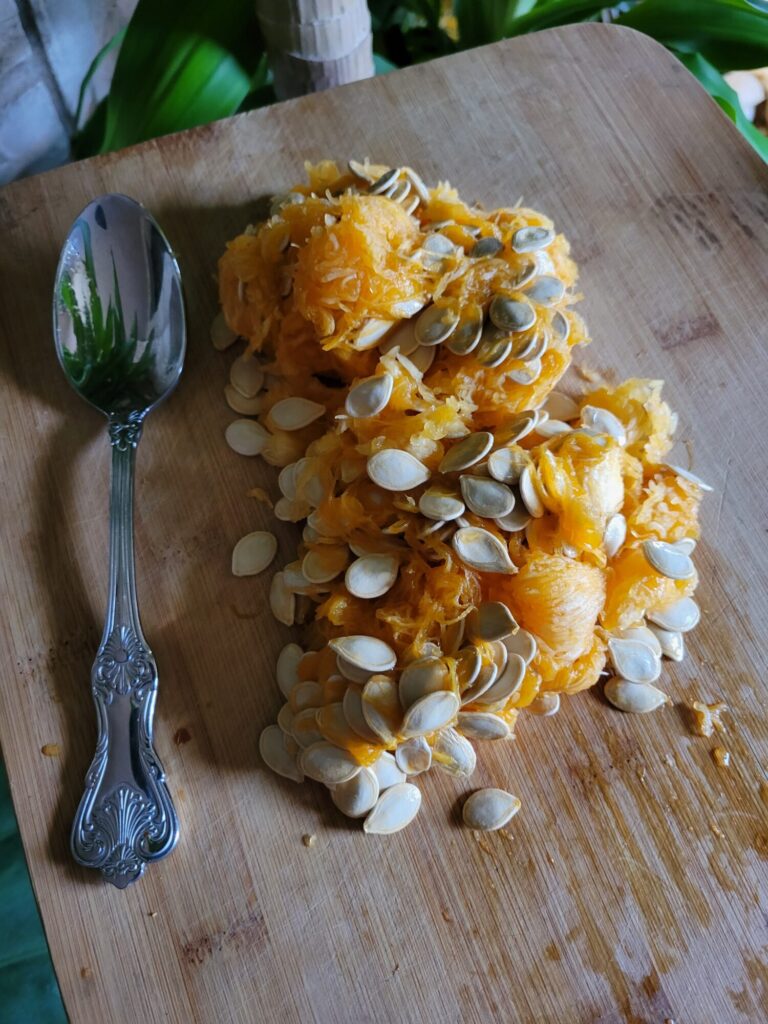
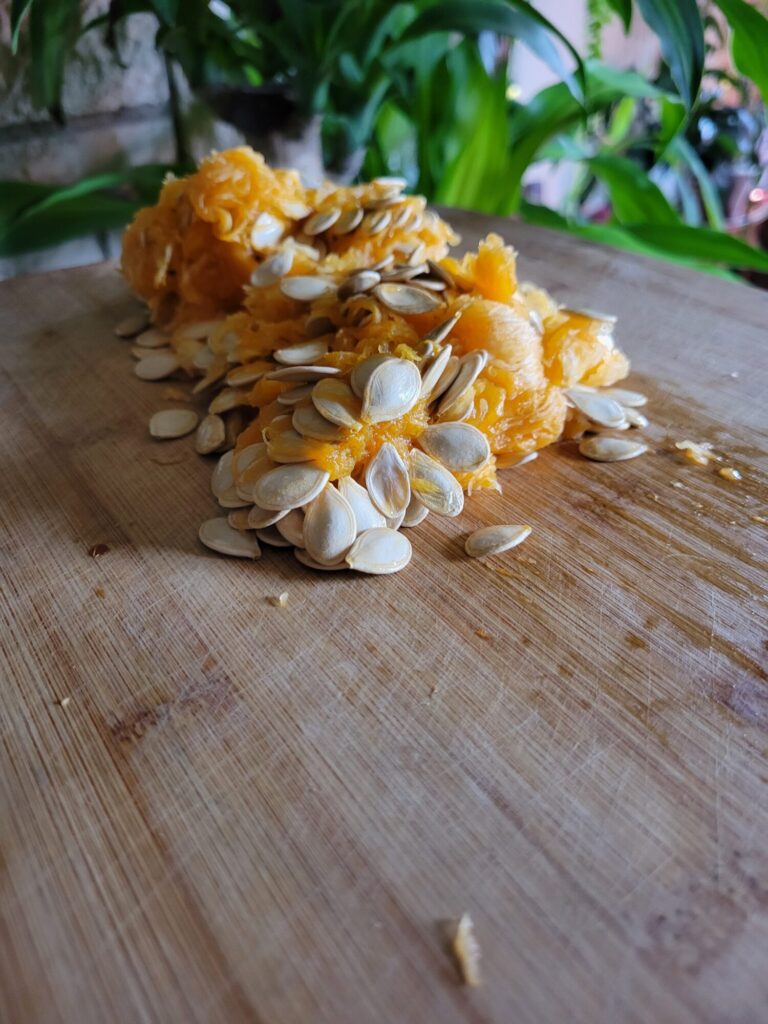
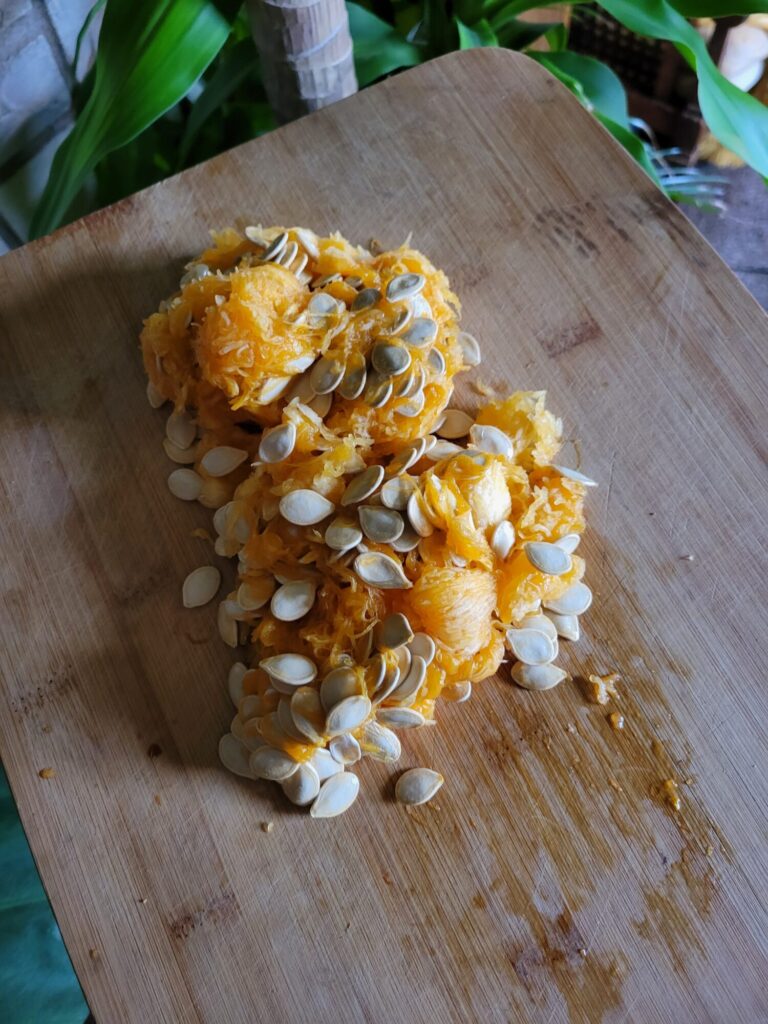
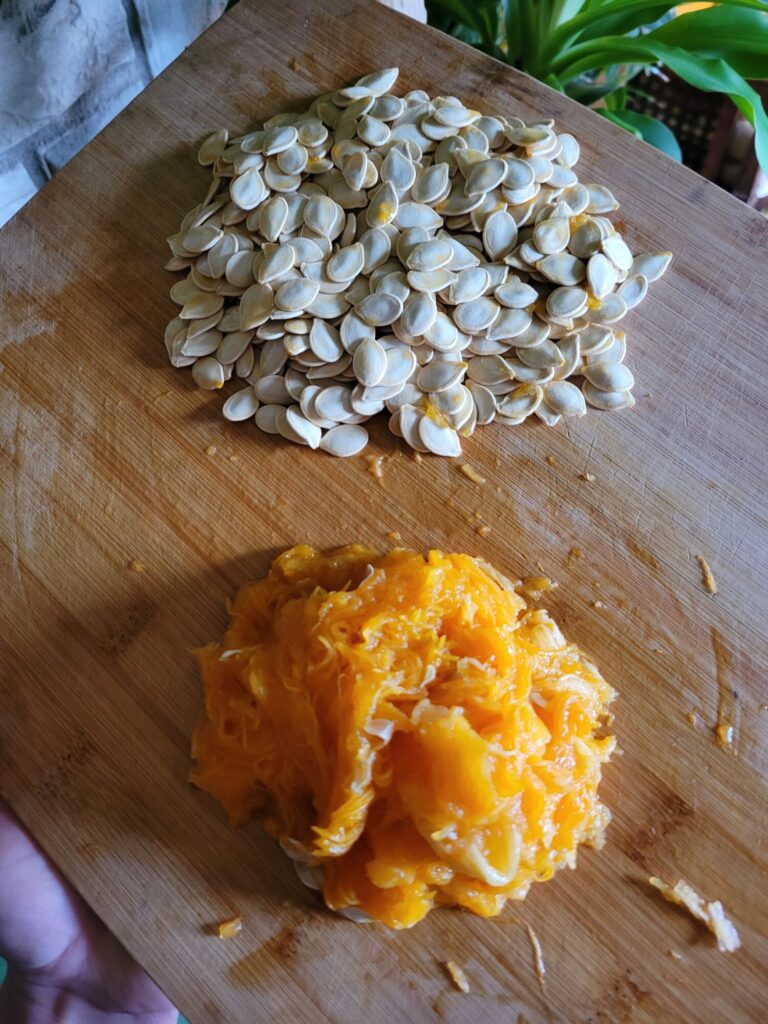
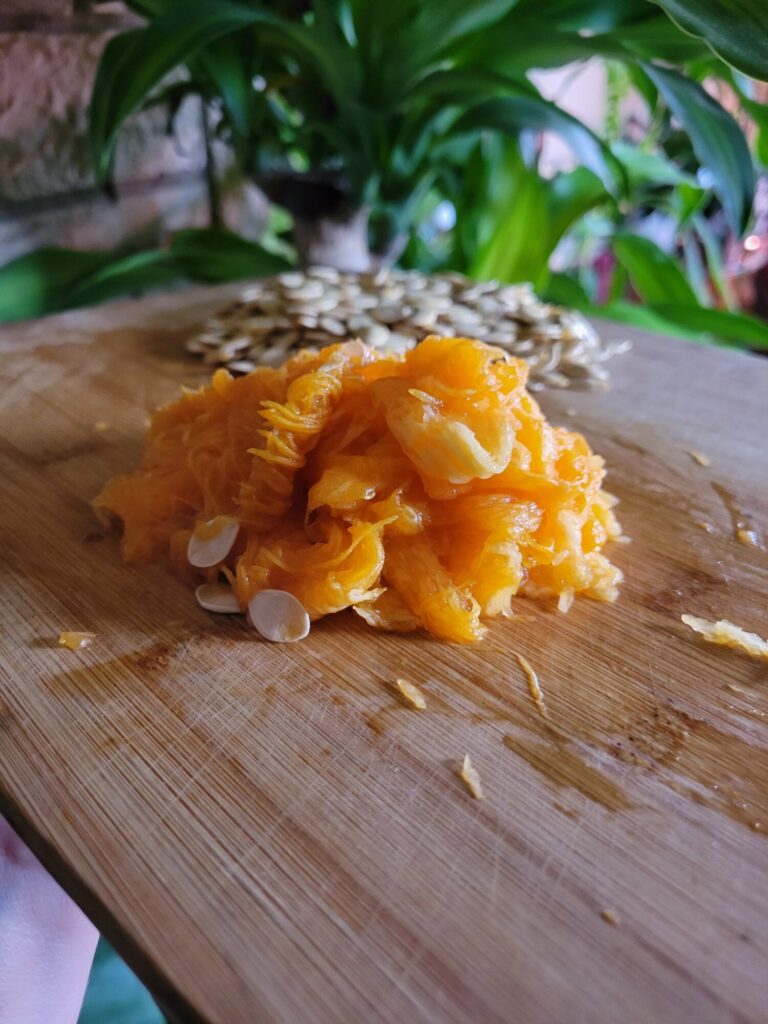
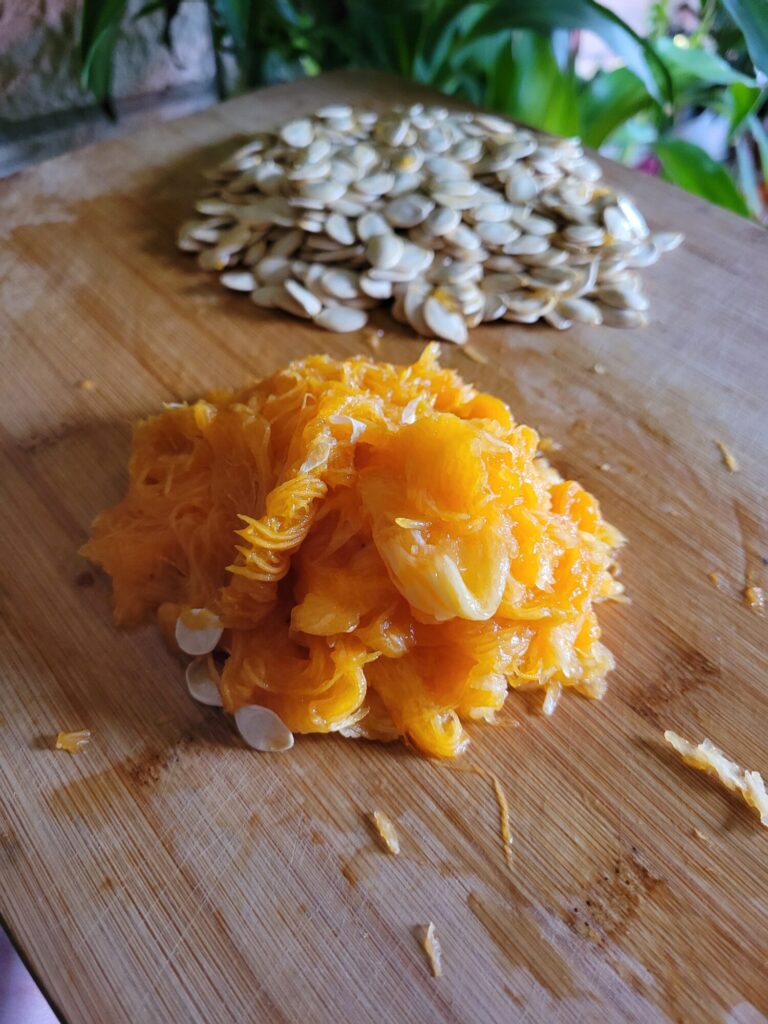


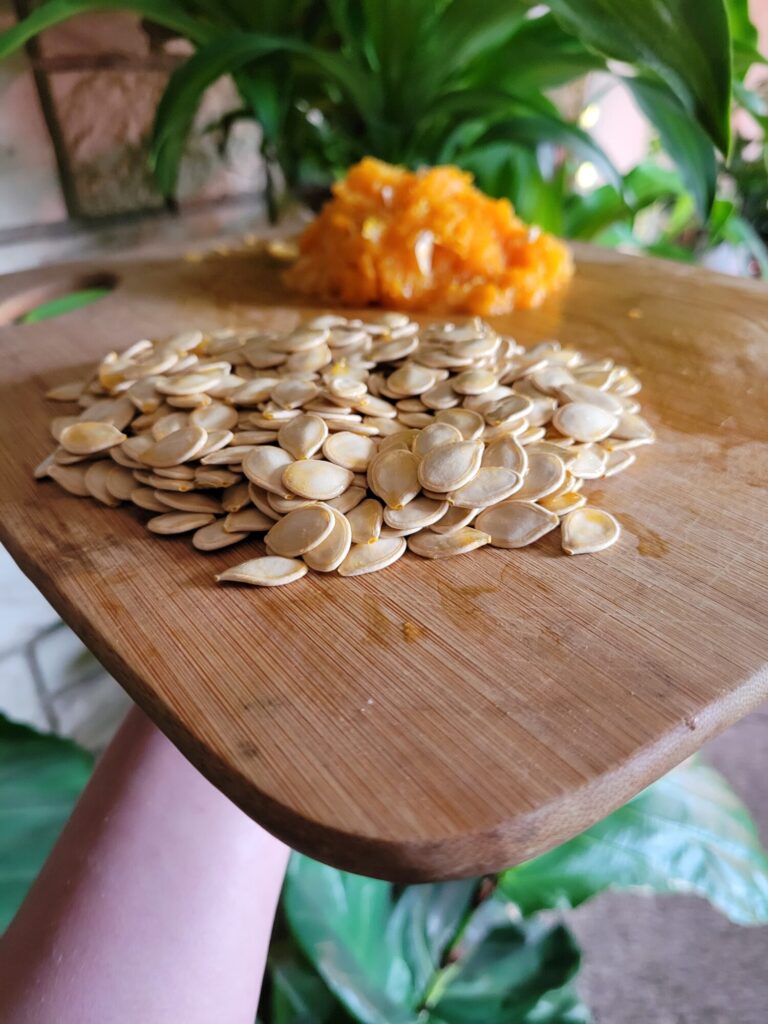
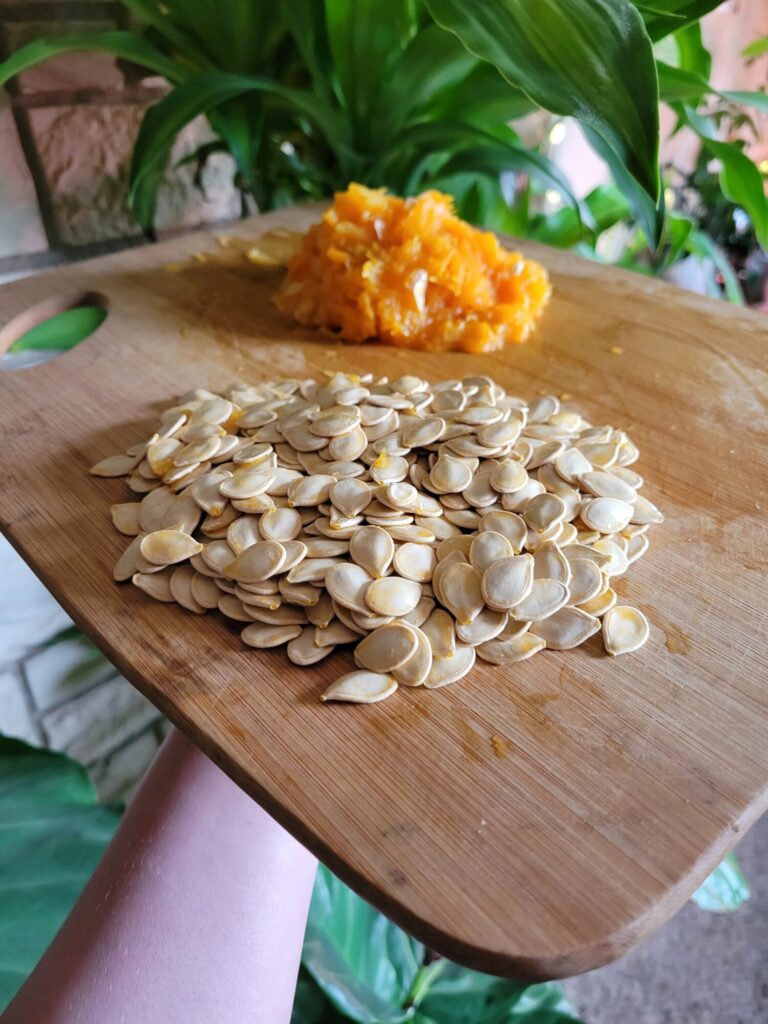

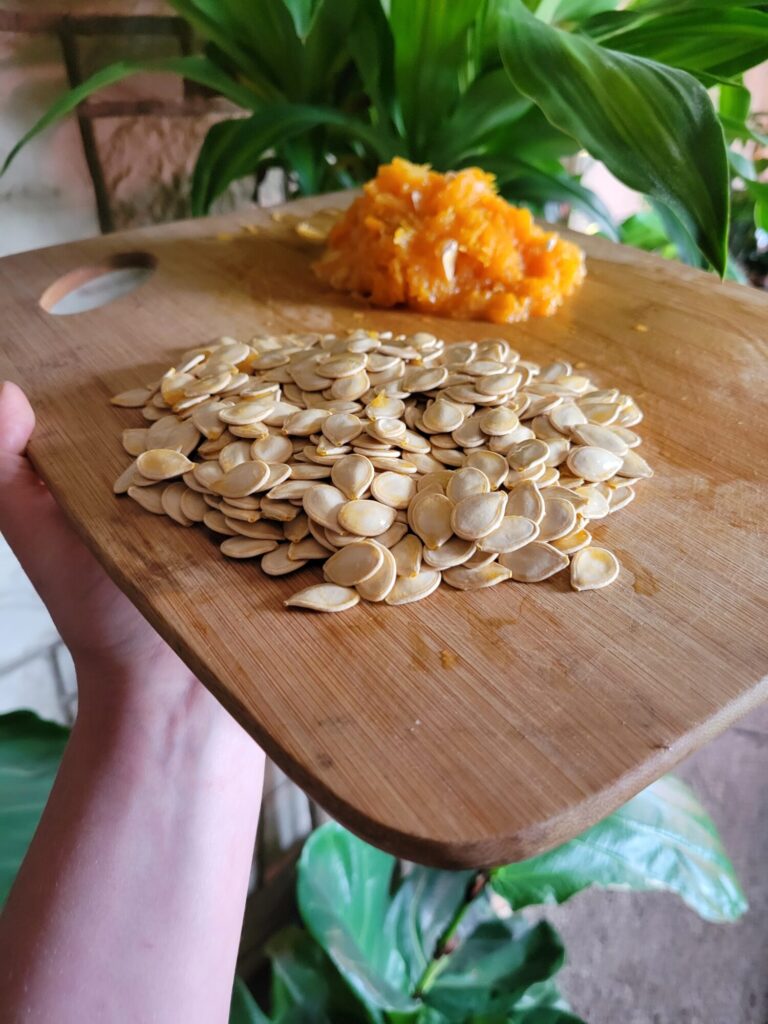

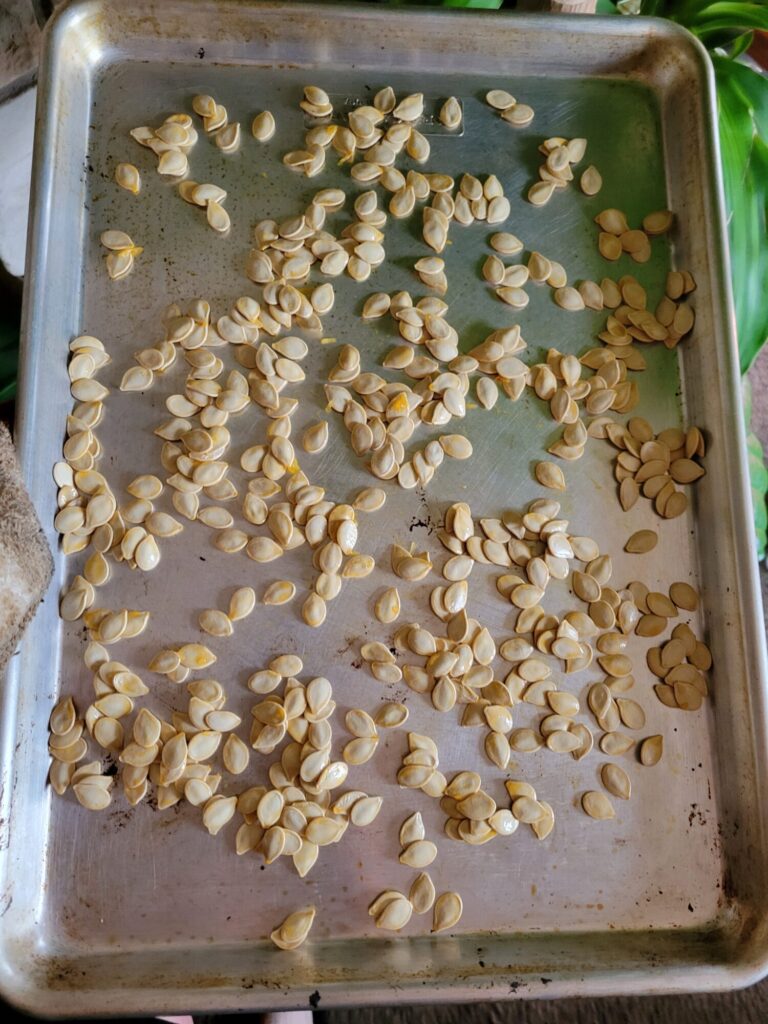

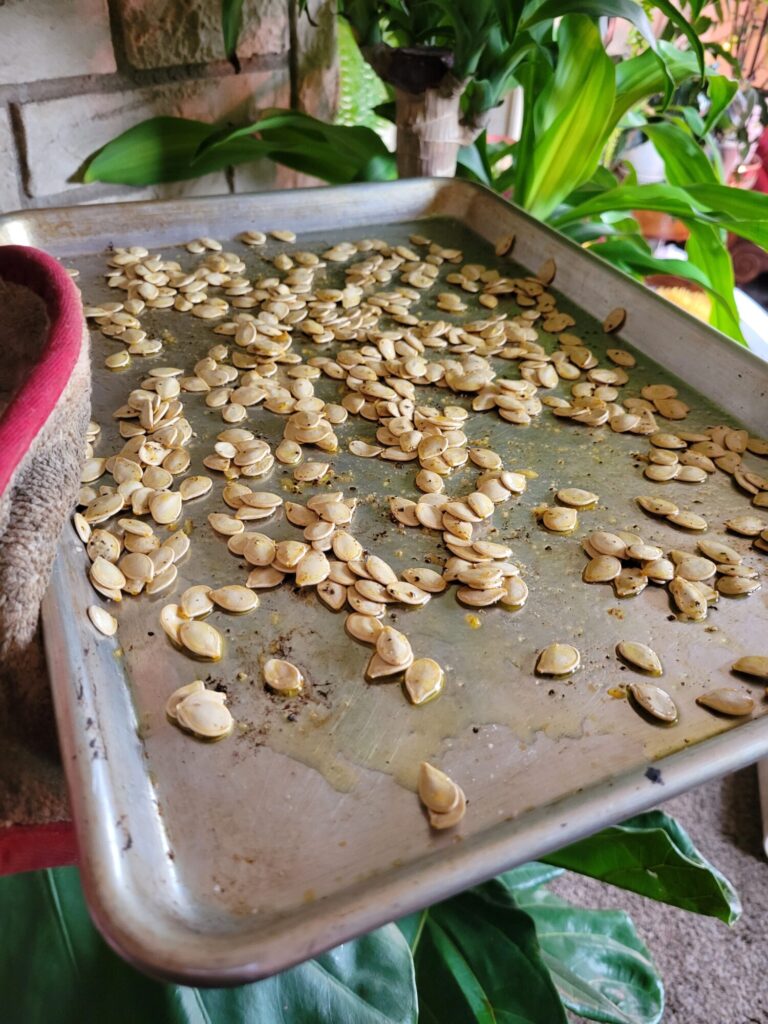

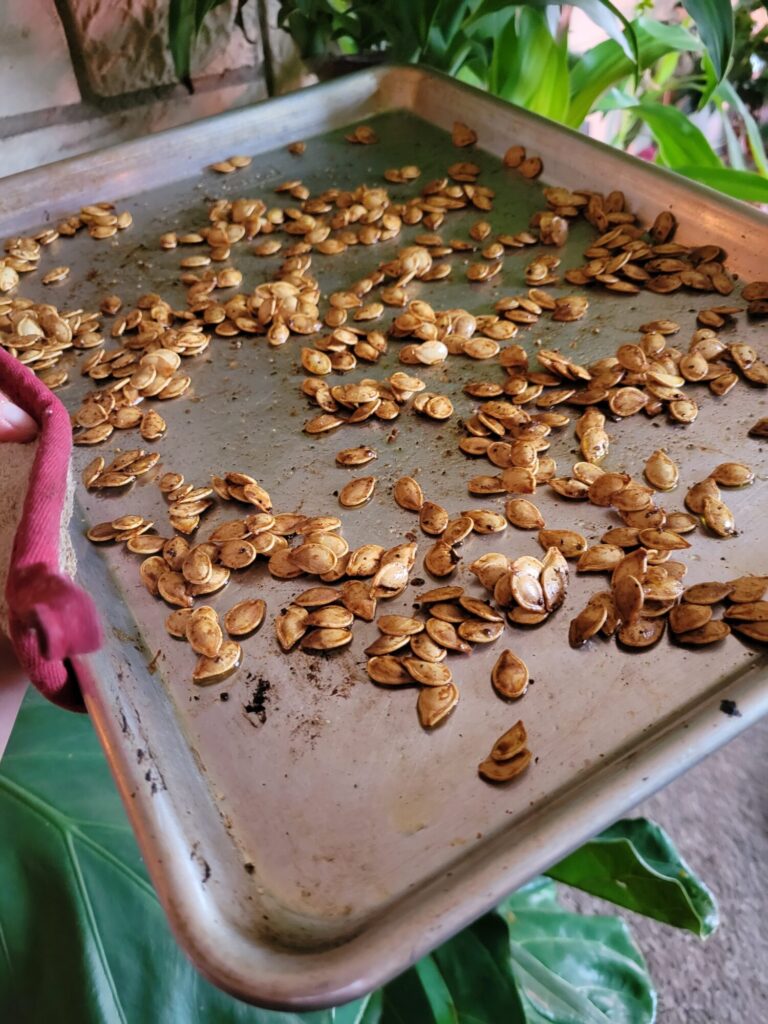
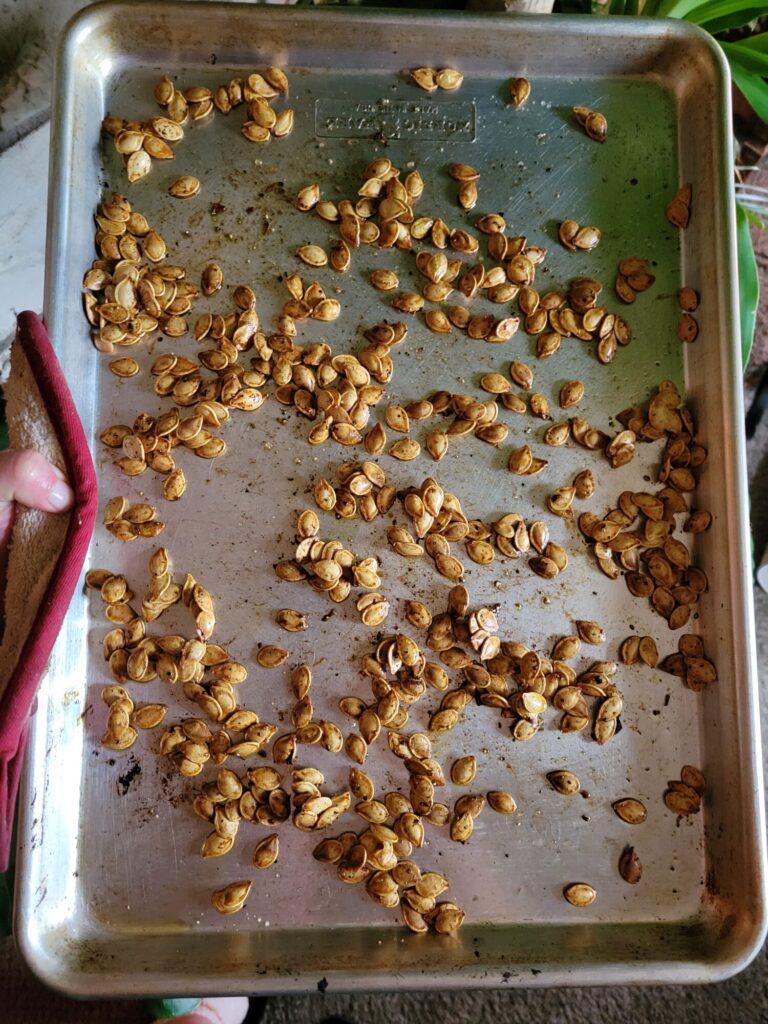
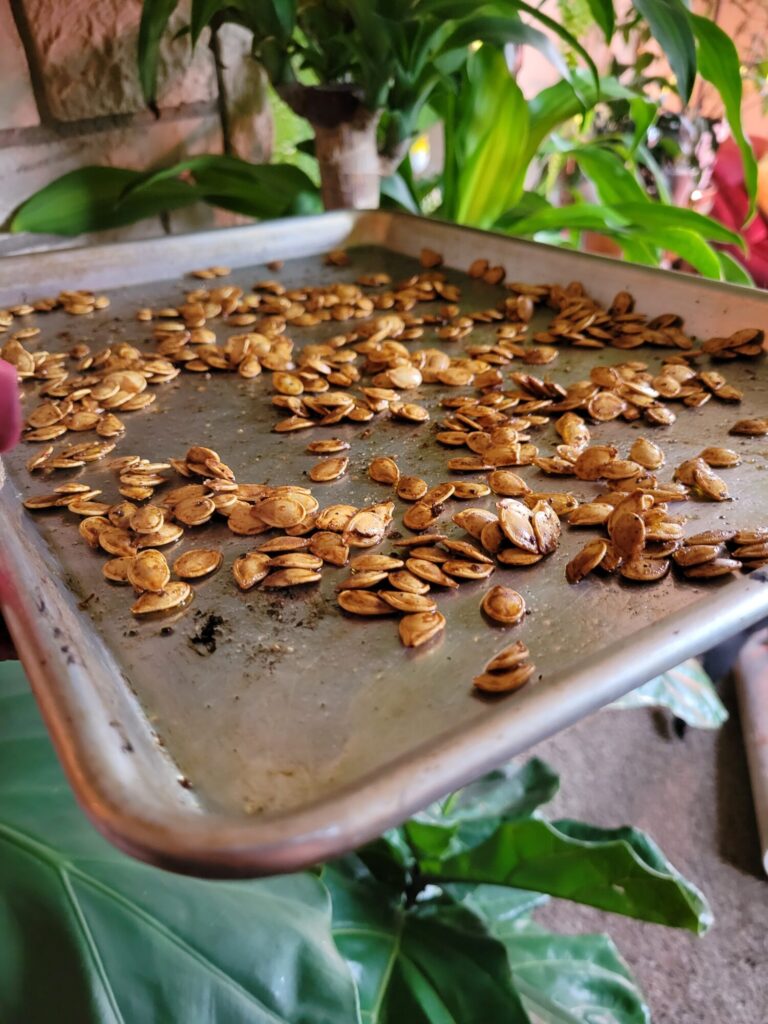

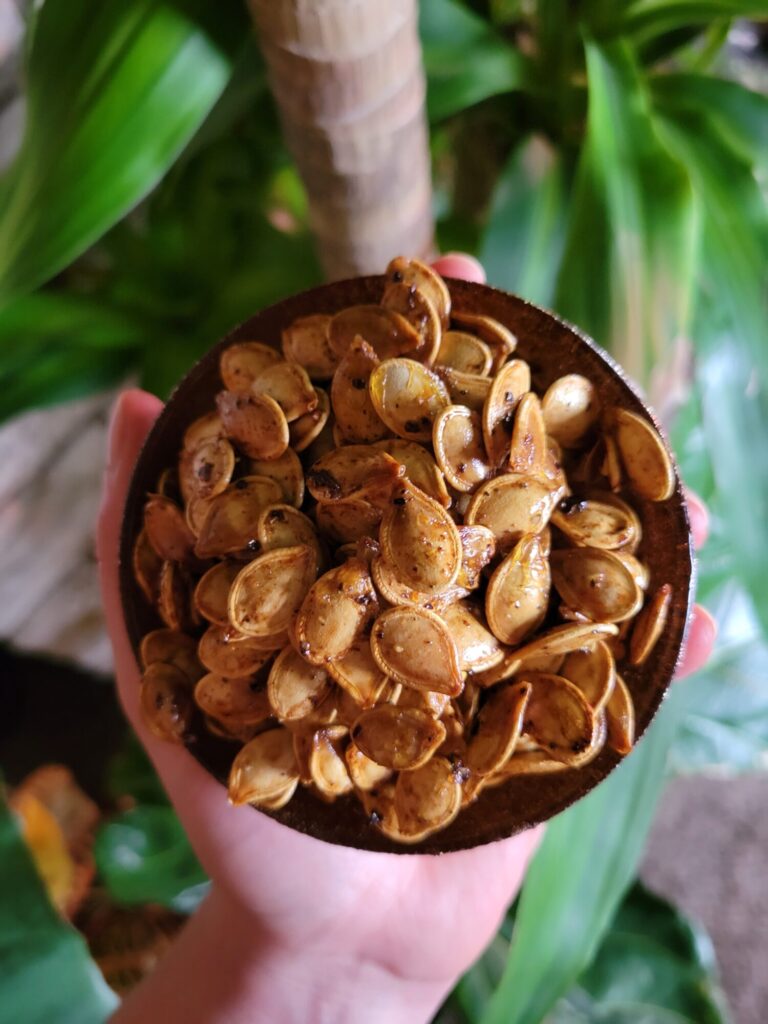


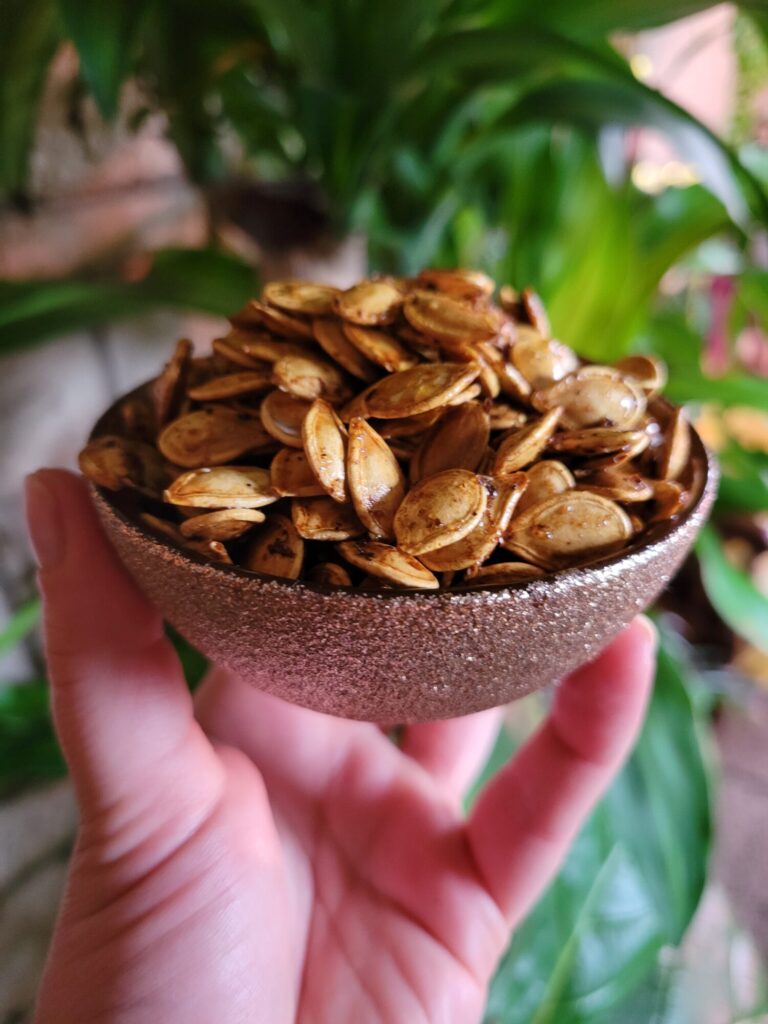
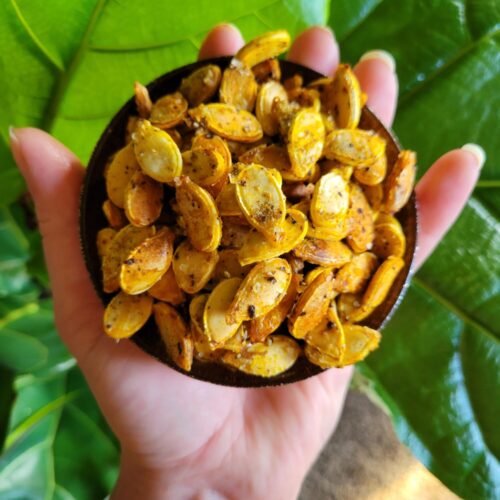
The Fundamentals of Roasted Pumpkin & Squash Seeds
Equipment
- Spoon
- Baking Sheet (or oven-safe skillet or baking dish)
- Oven
Ingredients
- seeds of 1 gourd (pumpkin, squash, or gourd of choice)
- ~1 tbsp. olive oil
- dash salt
- dash pepper (or spices of choice)
Instructions
- Preheat oven to 375 degrees Fahrenheit.
- Cut gourd in half.
- Using a spoon, scoop out the innards to remove all of the seeds and stringy pieces.
- Separate the seeds.This can be kind of tedious, but stick with it. The "guts" are still edible, but can be texturally unpleasant and burn faster than the seeds. I will usually keep them to puree into soup or pet food. However, most people will discard them! Just make sure not to toss any seeds!
- Add seeds to a bowl and sprinkle with olive oil, salt, pepper, and/or any seasoning of choice.For a pie pumpkin, butternut squash, or similarly-sized gourd, this is about 1/4 teaspoon. For larger squash and gourds, this can be up to a tablespoon. Although there is some leeway here for personal taste. To the standard American pallet, I tend to under-salt and over-spice a lot of foods! And I always figure, why be bland? Although there is no going back after you overdo it! So, it can be better to add sparingly and then add more later on.You also want just enough oil to coat them, but not drown them. You're roasting, not deep frying here! You can also do this directly on the baking sheet. Just be careful not to over oil them. You're roasted the seeds, not deep frying them!The exact amount of salt and pepper also depends on the amount of seeds and personal preference. You can always add more after roasting if you under season it.
- Spread across a baking sheet so that the seeds aren't touching too much.I will pat my fingers across the seeds to rapidly separate them. It's almost like trying to flatten the pile. The seeds will just slide away from one another. It's alright if they're touching, just not on top of one another.
- For smaller gourds, roast the seeds for 6-8 minutes, or until just golden brown. For larger ones, this can be up to 20 minutes.There is very little leeway when roasting seeds! The difference between perfectly golden brown and burnt can be as little as 30-60 seconds! Larger seeds are more forgiving. But, for the most part, I will check the seeds in the first 5 minutes and then recheck every 2 minutes until they're done. For larger seeds, which might take 15-20 minutes to roast, checking in 5 minute increments is perfectly acceptable as well.
- Remove from the oven and immediately the seeds or remove from the baking sheet entirely to let cool.They will continue to cook slightly on the baking sheet! So, if you don't mind them a little crisper, you can leave them on the tray. If they're definitely done or even overdone slightly, remove from the baking sheet as soon as possible! Otherwise, they may cook too much during the cooling process.
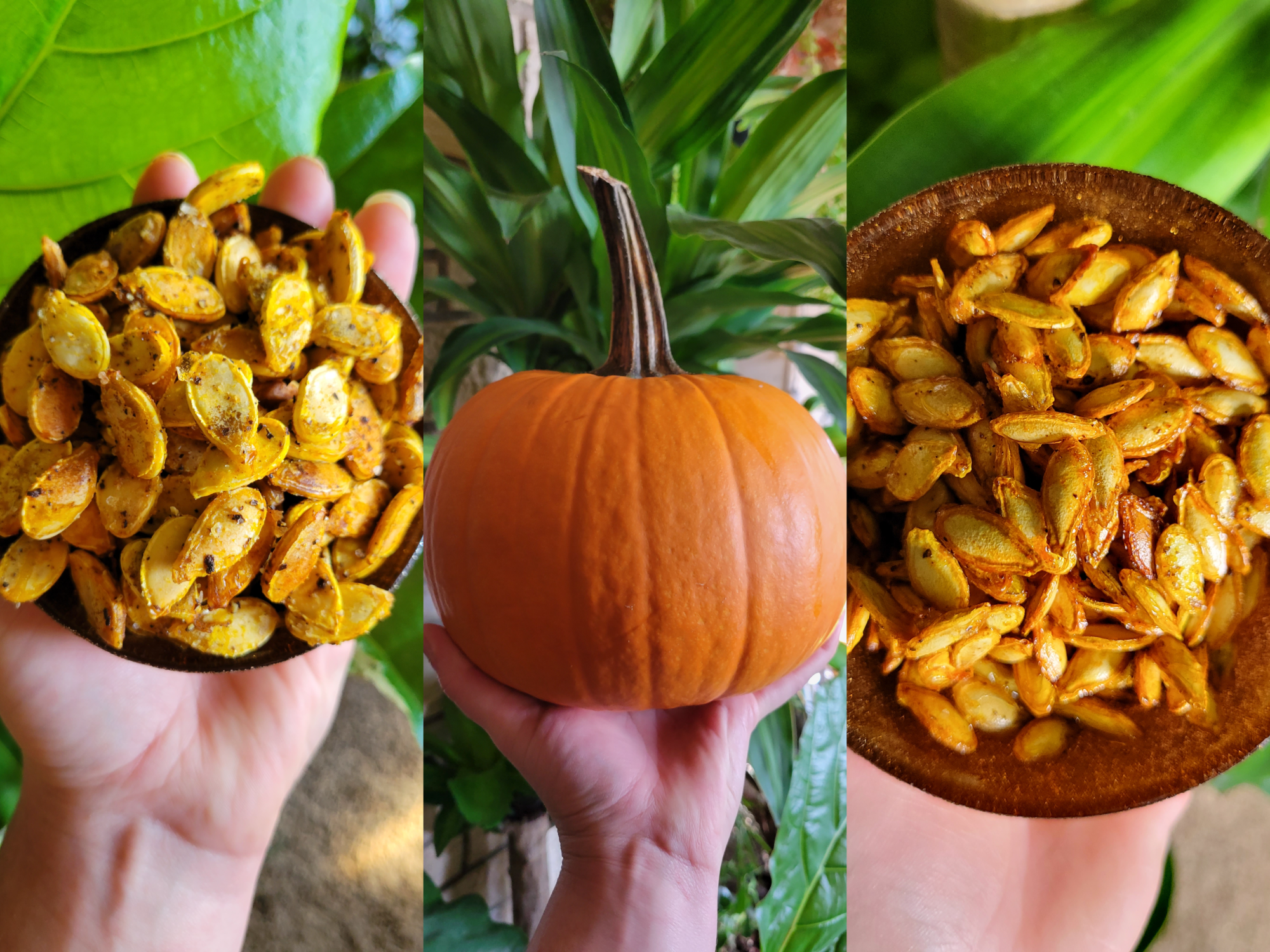

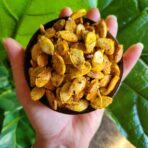


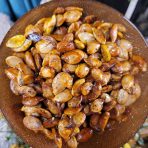
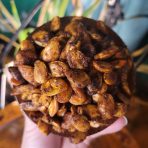
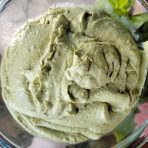

Leave a Reply